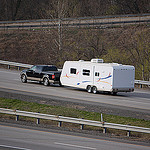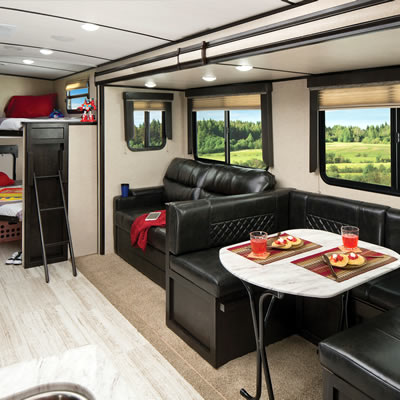The RV water pump
The water pump is a very important component of the RV water system.

Most RVs will have a built-in onboard fresh water tank to store water for those non-serviced camping excursions to the great outdoors, a sporting event or just taking a break at a roadside rest area.
Your RV manufacturer will also install a water pump to provide the water supply to the faucets, toilet, etc., which can be described as the on-demand water system. The pump may be as simple as a hand vacuum pump, which physically draws water from the water tank and will normally be found in older tent trailers and truck campers. The type of water pump found more commonly is a 12 volt DC unit, usually located near the water tank and activated by a switch at the monitor panel.
The two main manufacturers of RV water pumps, available in both 12 volt for most RVs and 110 volt for park models, are SHURflo and Flojet. The Aquatec and Artis brand water pumps can also be found in most RV parts catalogues. They are available in many different models, with some offering improved gallons per minute (GPM) flow, decreased noise levels and amp draws in addition to warranty coverage.
It is advisable to check the model installed in your RV to better identify parts, if parts are required. As an example, the inlet and outlet ports on the newer SHURflo and Flojet brands differ and adapters may be needed when interchanging brands.
Although the design of these pumps will differ slightly with all manufacturers, the parts will be similar in description and will operate until a predetermined water pressure is achieved and will automatically shut off. The RV pump external and internal components are the 12 volt DC motor, lower housing (consisting of the diaphragm/valve unit) and the upper housing, which contains the pressure switch assembly in addition to a check valve designed to withstand pressure from the city water hookup.
Many of the above listed parts can be purchased in kits. If you're the do-it-yourself type, servicing or replacing a water pump will only require a few basic tools. However, in some cases acrobatic skills are needed to locate and access the unit itself.
Warning signs
An RV water pump can be an excellent indicator of a water leak in your RV. If the pump cycles on and off frequently with all the faucets closed, you should be concerned and start opening cupboard doors, drawers and other access panels to check all water fittings and piping. This is the main reason not to leave your water pump on while you're away from the coach for a long period of time or while travelling to your next location. If a leak occurs in the system, the pump will continue to follow its job description and operate until the water tank is empty, with disastrous results and an insurance claim deductible payment.
Don't forget to check the pressure relief valve at your water heater. It can weep slightly if there is not a proper air space within the tank or if it needs replacing. A slight weep is be normal in most cases and the pump will still "burp" to compensate for the water pressure drop.
A common complaint we see at our shop every RV season, whether it be a retail customer or warranty issue on a pre-delivery inspection, is excessive noise. Many RV manufacturers will use PEX tubing, and when this is directly plumbed to the water pump it will cause vibration when the pump cycles for numerous reasons. You can do some basic troubleshooting by gaining access to the pump to check how it is secured, with attention to the rubber dampeners or feet and the location of the PEX pipe near interior walls and the floor.
In the case of an excessively noisy water pump, there are some options to allow the unit to operate more quietly and smoothly. Some hose kits are offered by your local RV parts supplier to create a soft line connection at the inlet or water tank supply and the outlet to the main line. You can also install an accumulator tank, which will provide a smoother flow of the water and reduce the number of times that the pump must cycle to deliver the same volume of water throughout the coach.
Frequently check the inline filter on your water pump to ensure it is clean and debris-free for improved water flow.
Your RV water pump is a very important component of the water system. It's the heart of the system, providing water for cooking and washing and even ice cubes for a well-deserved drink after a hard day relaxing in the sun. Ample water in the tank and adequate voltage is usually all that is required to provide a dependable and reliable flow of water.







